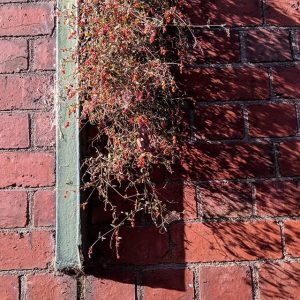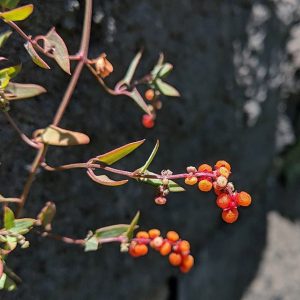Nodding Saltbush (Einadia nutans ssp. nutans), an indigenous Australian specialist of rocky and otherwise obstructed environments, and a surprising urban colonist.
There is a repeated notion online that Nodding Saltbush shows up as a persistent survivor in otherwise disturbed natural areas, an observation made in good faith but tinged with the positive moralism that attaches to native plants. The urban reappearance of Nodding Saltbush in Melbourne suggests an alternative reading of its persistence: that this is a plant whose capacities make it a successful volunteer in constrained niches where there is a nearby seed source and animal transport (eg. small birds) to get it there. If ‘there’ is a degraded natural site like the steep banks and sandstone exposures along the Yarra and some of its tributaries, we can happily celebrate this spontaneous/persistent revegetation; when it appears in constructed urban context, we can also celebrate its capability and persistence as a weed, no negative epithet or glyphosate required.
Although most botanical records of the species within metropolitan Melbourne were made comparatively early, the plant is possibly underrecorded as an urban volunteer given the narrow and often vertical terrain it inhabits and its absence (as an indig. species) from local weed inventories, a major source of modern classification records in suburban areas. As local seed sources multiply thanks to its widespread adoption as a revegetation plant, the species is likely to emerge as a more common volunteer of urban shingle and vertical structure within the metropolitan. It may also appear to be ‘persisting’ in more disturbed natural areas than it did before!
In the last month, I have seen Nodding Saltbush twice as a structural colonist: in the bluestone embankment wall at Rucker’s Hill (emerging from beneath the brick parapet), and similarly emerging from the footpath slab above a brick retaining wall at Jolimont Railway Station in East Melbourne. It also grows atop the Barkers Road bedrock cuttings in Kew, a narrow, weedy exposure that does not receive intentional planting.
View Original Post on Instagram
Search for information about Einadia nutans ssp. nutans in the Flora of Victoria
View information and occurrences of Einadia nutans ssp. nutans on the Atlas of Living Australia












August 29, 2019 at 12:55 PM
It occurs in various Melbourne locations, particularly in the northwest. Rare in wetter locations such as Kinglake. Cannot understand why this would be considered a weed.
August 29, 2019 at 10:41 PM
Roger, Einadia nutans is a fantastic and ultra-tough indigenous plant. As described in the text, this makes it a capable colonist of urban strata, including stone and masonry walls and asphalt pavements. In those contexts, it is an exciting and interesting weed.
As you’ll read on the ‘About’ page, this project uses the term ‘weed’ amorally, and with its broadest definition, as a descriptor for plants growing where they are unwanted or not supposed to be. This definition absolutely does describe the growth habits and occurrences of some native and indigenous species; where there are no obviously negative consequences of their adaptability and vigour, this should be read as a celebratory epithet.